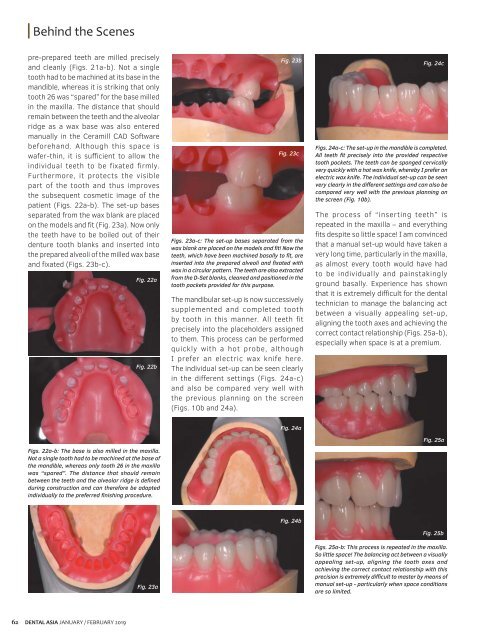Dental Asia January/February 2019
For more than two decades, Dental Asia is the premium journal in linking dental innovators and manufacturers to its rightful audience. We devote ourselves in showcasing the latest dental technology and share evidence-based clinical philosophies to serve as an educational platform to dental professionals. Our combined portfolio of print and digital media also allows us to reach a wider market and secure our position as the leading dental media in the Asia Pacific region while facilitating global interactions among our readers.
For more than two decades, Dental Asia is the premium journal in linking dental innovators
and manufacturers to its rightful audience. We devote ourselves in showcasing the latest dental technology and share evidence-based clinical philosophies to serve as an educational platform to dental professionals. Our combined portfolio of print and digital media also allows us to reach a wider market and secure our position as the leading dental media in the Asia Pacific region while facilitating global interactions among our readers.
You also want an ePaper? Increase the reach of your titles
YUMPU automatically turns print PDFs into web optimized ePapers that Google loves.
Behind the Scenes<br />
pre-prepared teeth are milled precisely<br />
and cleanly (Figs. 21a-b). Not a single<br />
tooth had to be machined at its base in the<br />
mandible, whereas it is striking that only<br />
tooth 26 was “spared” for the base milled<br />
in the maxilla. The distance that should<br />
remain between the teeth and the alveolar<br />
ridge as a wax base was also entered<br />
manually in the Ceramill CAD Software<br />
beforehand. Although this space is<br />
wafer-thin, it is sufficient to allow the<br />
individual teeth to be fixated firmly.<br />
Furthermore, it protects the visible<br />
part of the tooth and thus improves<br />
the subsequent cosmetic image of the<br />
patient (Figs. 22a-b). The set-up bases<br />
separated from the wax blank are placed<br />
on the models and fit (Fig. 23a). Now only<br />
the teeth have to be boiled out of their<br />
denture tooth blanks and inserted into<br />
the prepared alveoli of the milled wax base<br />
and fixated (Figs. 23b-c).<br />
Fig. 22a<br />
Fig. 22b<br />
Fig. 23b<br />
Fig. 23c<br />
Figs. 23a-c: The set-up bases separated from the<br />
wax blank are placed on the models and fit! Now the<br />
teeth, which have been machined basally to fit, are<br />
inserted into the prepared alveoli and fixated with<br />
wax in a circular pattern. The teeth are also extracted<br />
from the D-Set blanks, cleaned and positioned in the<br />
tooth pockets provided for this purpose.<br />
The mandibular set-up is now successively<br />
supplemented and completed tooth<br />
by tooth in this manner. All teeth fit<br />
precisely into the placeholders assigned<br />
to them. This process can be performed<br />
quickly with a hot probe, although<br />
I prefer an electric wax knife here.<br />
The individual set-up can be seen clearly<br />
in the different settings (Figs. 24a-c)<br />
and also be compared very well with<br />
the previous planning on the screen<br />
(Figs. 10b and 24a).<br />
Fig. 24c<br />
Figs. 24a-c: The set-up in the mandible is completed.<br />
All teeth fit precisely into the provided respective<br />
tooth pockets. The teeth can be sponged cervically<br />
very quickly with a hot wax knife, whereby I prefer an<br />
electric wax knife. The individual set-up can be seen<br />
very clearly in the different settings and can also be<br />
compared very well with the previous planning on<br />
the screen (Fig. 10b).<br />
The process of “inserting teeth” is<br />
repeated in the maxilla – and everything<br />
fits despite so little space! I am convinced<br />
that a manual set-up would have taken a<br />
very long time, particularly in the maxilla,<br />
as almost every tooth would have had<br />
to be individually and painstakingly<br />
ground basally. Experience has shown<br />
that it is extremely difficult for the dental<br />
technician to manage the balancing act<br />
between a visually appealing set-up,<br />
aligning the tooth axes and achieving the<br />
correct contact relationship (Figs. 25a-b),<br />
especially when space is at a premium.<br />
Figs. 22a-b: The base is also milled in the maxilla.<br />
Not a single tooth had to be machined at the base of<br />
the mandible, whereas only tooth 26 in the maxilla<br />
was “spared”. The distance that should remain<br />
between the teeth and the alveolar ridge is defined<br />
during construction and can therefore be adapted<br />
individually to the preferred finishing procedure.<br />
Fig. 24a<br />
Fig. 25a<br />
Fig. 23a<br />
Fig. 24b<br />
Fig. 25b<br />
Figs. 25a-b: This process is repeated in the maxilla.<br />
So little space! The balancing act between a visually<br />
appealing set-up, aligning the tooth axes and<br />
achieving the correct contact relationship with this<br />
precision is extremely difficult to master by means of<br />
manual set-up - particularly when space conditions<br />
are so limited.<br />
62<br />
DENTAL ASIA JANUARY / FEBRUARY <strong>2019</strong>


















